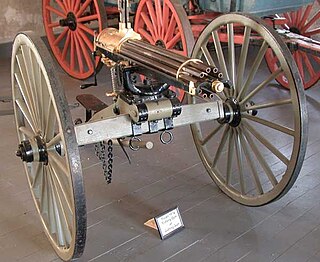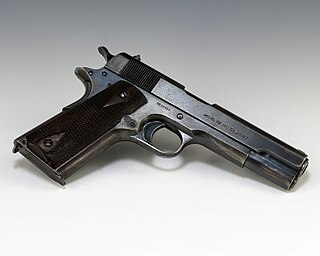
A firearm is any type of gun that uses an explosive charge and is designed to be readily carried and used by an individual. The term is legally defined further in different countries.

The Gatling gun is a rapid-firing multiple-barrel firearm invented in 1861 by Richard Jordan Gatling. It is an early machine gun and a forerunner of the modern electric motor-driven rotary cannon.

A machine gun (MG) is a fully automatic, rifled auto-loading firearm designed for sustained direct fire with rifle cartridges. Other automatic firearms such as automatic shotguns and automatic rifles are typically designed more for firing short bursts rather than continuous firepower and are not considered true machine guns. Submachine guns fire handgun cartridges rather than rifle cartridges, therefore they are not considered machine guns, while automatic firearms of 20 mm (0.79 in) caliber or more are classified as autocannons rather than machine guns.

Flintlock is a general term for any firearm that uses a flint-striking ignition mechanism, the first of which appeared in Western Europe in the early 16th century. The term may also apply to a particular form of the mechanism itself, also known as the true flintlock, that was introduced in the early 17th century, and gradually replaced earlier firearm-ignition technologies, such as the matchlock, the wheellock, and the earlier flintlock mechanisms such as the snaplock and snaphaunce.

The double-barreled cannon is an American Civil War-era experimental weapon and is now a modern landmark located in Athens, Georgia. While originally built for warfare, the cannon never saw battle. It is part of the Downtown Athens Historic District, in the National Register of Historic Places.

The pepper-box revolver or simply pepperbox is a multiple-barrel firearm, mostly in the form of a handgun, that has three or more gun barrels in a revolving mechanism. Each barrel holds a single shot, and the shooter can manually rotate the whole barrel assembly to sequentially index each barrel into alignment with the lock or hammer, similar to rotation of a revolver's cylinder.
A repeating rifle is a single-barreled rifle capable of repeated discharges between each ammunition reload. This is typically achieved by having multiple cartridges stored in a magazine and then fed individually into the chamber by a reciprocating bolt, via either a manual or automatic action mechanism, while the act of chambering the round typically also recocks the hammer/striker for the following shot. In common usage, the term "repeating rifle" most often refers specifically to manual repeating rifles, as opposed to self-loading rifles, which use the recoil, gas, or blowback of the previous shot to cycle the action and load the next round, even though all self-loading firearms are technically a subcategory of repeating firearms.

A mitrailleuse is a type of volley gun with barrels of rifle calibre that can fire either all rounds at once or in rapid succession. The earliest true mitrailleuse was invented in 1851 by Belgian Army captain Fafschamps, ten years before the advent of the Gatling gun. It was followed by the Belgian Montigny mitrailleuse in 1863. Then the French 25 barrel "Canon à Balles", better known as the Reffye mitrailleuse, was adopted in great secrecy in 1866. It became the first rapid-firing weapon deployed as standard equipment by any army in a major conflict when it was used during the Franco-Prussian War of 1870–71.

A salvo is the simultaneous discharge of artillery or firearms including the firing of guns either to hit a target or to perform a salute. As a tactic in warfare, the intent is to cripple an enemy in many blows at once and prevent them from fighting back.

A ribauldequin, also known as a rabauld, randy, ribault, ribaudkin, infernal machine or organ gun, was a late medieval volley gun with many small-caliber iron barrels set up parallel on a platform, in use from the 14th through 17th centuries. When the gun was fired, multiple barrels discharged their projectiles at once, yielding a much higher rate of fire than single-barrel guns. Organ guns were lighter and more mobile than most previous artillery pieces, making them more suitable for engaging enemy personnel rather than fixed fortifications such as castles. The name organ gun comes from the resemblance of the multiple barrels to a pipe organ. As an early type of multiple-barrel firearm, the ribauldequin is sometimes considered the predecessor of the 19th century mitrailleuse.

The Nock gun was a seven-barrelled flintlock smoothbore firearm used by the Royal Navy during the early stages of the Napoleonic Wars. It is a type of volley gun adapted for ship-to-ship fighting, but was limited in its use because of the powerful recoil and eventually discontinued.
Naval artillery in the Age of Sail encompasses the period of roughly 1571–1862: when large, sail-powered wooden naval warships dominated the high seas, mounting a large variety of types and sizes of cannon as their main armament. By modern standards, these cannon were extremely inefficient, difficult to load, and short ranged. These characteristics, along with the handling and seamanship of the ships that mounted them, defined the environment in which the naval tactics in the Age of Sail developed.

A pistol is a type of handgun, characterized by a barrel with an integral chamber. The word "pistol" is derived from the Middle French pistolet, meaning a small gun or knife, and first appeared in the English language c. 1570 when early handguns were produced in Europe. In colloquial usage, the word "pistol" is often used as a generic term to describe any type of handgun, inclusive of revolvers and the pocket-sized derringers.

In firearms, the cylinder is the cylindrical, rotating part of a revolver containing multiple chambers, each of which is capable of holding a single cartridge. The cylinder rotates (revolves) around a central axis in the revolver's action to sequentially align each individual chamber with the barrel bore for repeated firing. Each time the gun is cocked, the cylinder indexes by one chamber. Serving the same function as a rotary magazine, the cylinder stores ammunitions within the revolver and allows it to fire multiple times before needing to reload.

The Montigny mitrailleuse was an early type of crank-operated machine-gun developed by the Belgian gun works of Joseph Montigny between 1859 and 1870. It was an improved version of the "Mitrailleuse", invented by Belgian Captain Fafschamps in 1851 which was a fixed 50-barrelled volley gun.

A multiple-barrel firearm is any type of firearm with more than one gun barrel, usually to increase the rate of fire or hit probability and to reduce barrel erosion or overheating.
The Henrion, Dassy & Heuschen double-barrel revolver was a type of revolver with two stacked barrels and two concentric sets of chambers, each serving its own barrel. They were fired by a single hammer which had two firing pins. The chambers were staggered, such that the gun fired only round at a time. These revolvers were based on a 1910 patent held by the Belgian firm of Henrion, Dassy & Heuschen (HDH), and were made in various calibers.

Henry Nock (1741–1804) was a British inventor and engineer of the Napoleonic period, best known as a gunmaker. Nock produced many innovative weapons including the screwless lock and the seven-barrelled volley gun, although he did not invent the latter despite it commonly being known as the Nock gun. He was a major supplier to the military during the Napoleonic wars. His high quality duelling pistols and double-barrelled shotguns were much sought after and it is largely through Nock that the latter became the weapon of choice for hunters.

The S333 Thunderstruck is an aluminum-frame revolver designed and manufactured by Standard Manufacturing of New Britain, Connecticut. Introduced in 2019 and intended for concealed carry, is notable for being a volley gun, as each pull of the trigger simultaneously fires two .22 Winchester Magnum Rimfire cartridges.

A repeating firearm or repeater is any firearm that is capable of being fired repeatedly before having to be manually reloaded with new ammunition into the firearm.





















